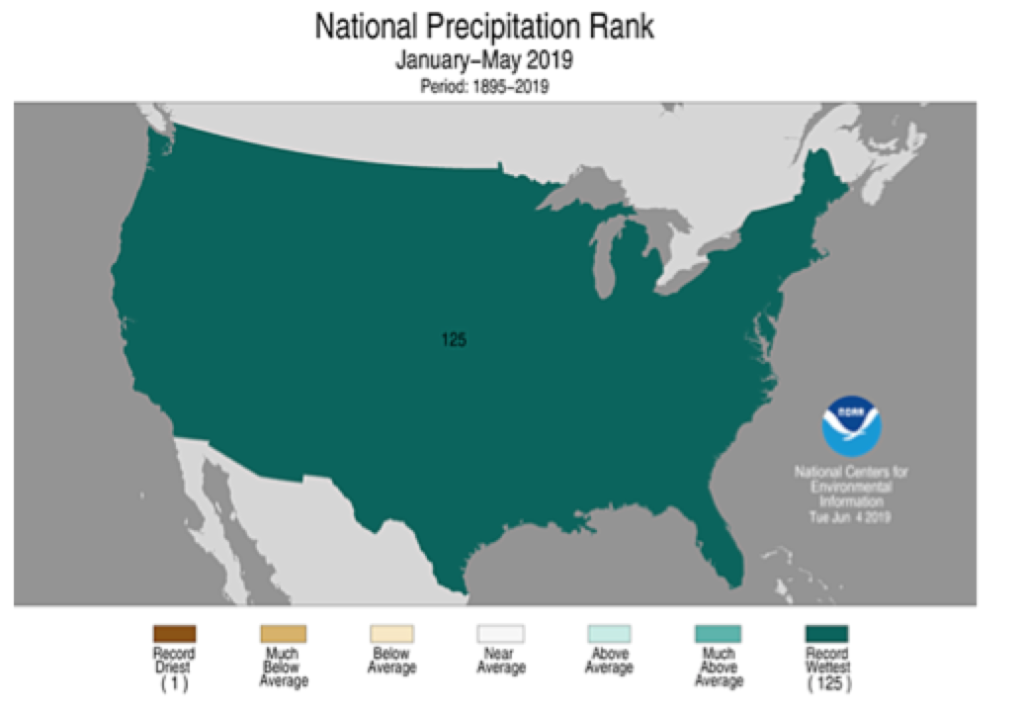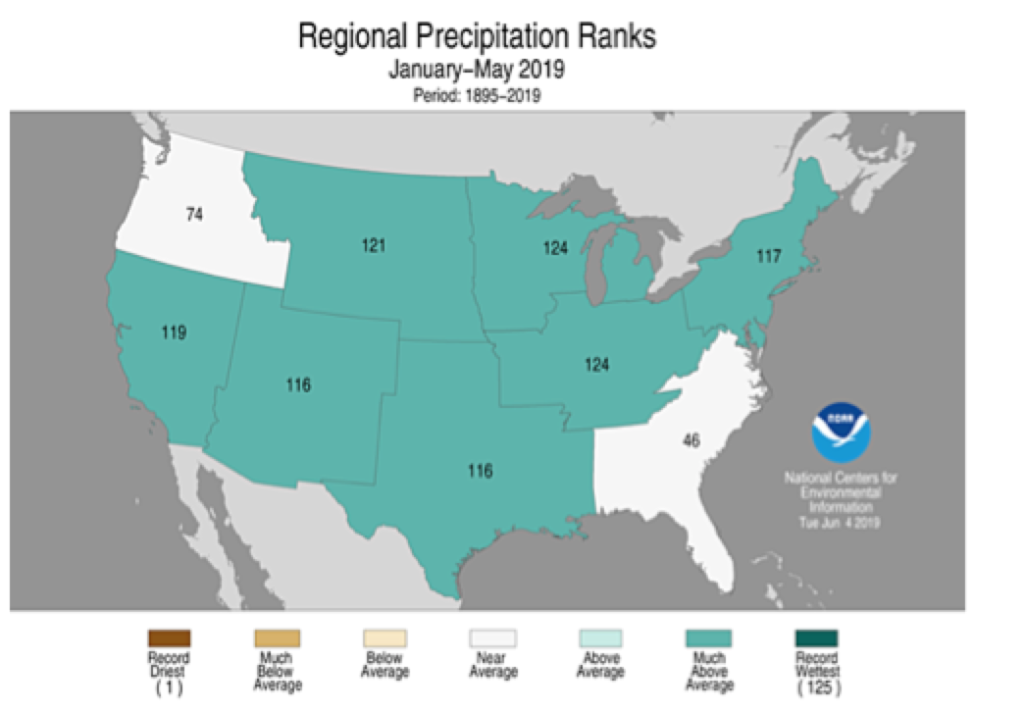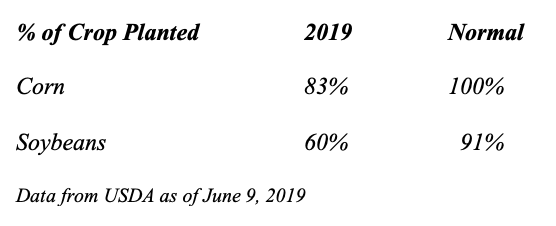The Corn Is Not As High As An Elephant’s Eye

“There’s a bright golden haze on the meadow,
There’s a bright golden haze on the meadow,
The corn is as high as an elephant’s eye,
An’ it looks like its climbin’ clear up to the sky.
Oh what a beautiful morning,
Oh what a beautiful day,
I’ve got a wonderful feeling,
Everything’s going my way.”
Oh, What A Beautiful Morning
Oklahoma!, 1943
Music and Lyrics by Richard Rodgers and Oscar Hammerstein II
For the farmer, weather can play an outsize role in the outcome. Some years are perfect, with just the right amount of sun and rain. In those years, the farmer produces bumper crops. Other years are hot and dry, withering the crops in the field no matter how much the farmer waters. And in yet other years, the heavens unload, dropping copious amounts of rain on the fields, interfering with planting and literally raining disaster down on the farmer. The Year 2019 appears ready to shape up as the latter for the US farmer.
Government data indicate this year, to date, stands as the wettest on record, since records began to be kept in 1895. The following picture from NOAA demonstrates in pictorial form just how wet this year has been:

As the picture demonstrates, should precipitation continue at this rate, 2019 would become the record year for rainfall for the US as a whole. And for the farmer in the Midwest focused on planting corn and soybeans, this year will rank in one of the Top 5 in the Upper Midwest and in the Top 10 for the rest of the farm belt:

For the farmer praying for some sun to dry out his or her fields to plant crops, this stands as bad news. Crop plantings stand significantly behind normal:

As the above data demonstrate, plantings stand well behind normal. For corn, if the crop is not in the ground by June 5, then the farmer cannot obtain crop insurance. So, the 17% of corn acreage not planted yet stand at risk of never being planted with corn this year. These acres likely will transition to soybeans, which have a latter planting deadline of June 10 to June 30, depending on the location. But with the fields so wet, planting soybeans by the date needed for crop insurance stands as no sure bet. Unless the sun shines soon, a large portion of US acreage stands at risk of lying fallow this year.
For the Global Supply-Demand Balance, this possesses significant implications. The U.S. produces the largest corn crop in the world and one of the top soybean crops as well. As a result, a shortfall in the US crops will impact the globe. According to the USDA World Agricultural Supply and Demand Report (WASDE), the US farmer produced 25% of the world’s “Coarse Grains” in the 2018/2019 Crop Year, principally corn, and a little under 21% of Oilseeds, which are principally soybeans. Based on the latest USDA Yield Projections, the farmer will harvest just 166 bushels of corn per acre, the lowest since the 2013/2014 Crop Year. And if this year’s rainfall continues at the pace that currently exists, that harvest yield could shrink considerably. Already, Corn Stocks to Use are projected to end the year below 12%. (The WASDE report is available at https://www.usda.gov/oce/commodity/wasde/wasde0619.pdf .)
And while the rainfall continues to impact the farmer’s production, lower yields will meet higher prices leaving farm Corn cash receipts strong. In March, prior to the current run-up in Corn prices, the USDA forecast Corn crop receipts, as of March 6, 2019, at $50.8 billion this year compared to $48.3 billion last year. Since then, prices have gone from $3.50 to $4.50 per bushel, up 28%+, while harvested bushels are only forecast down 9%. Even should the actual harvest drop 15%, the farmer still stands 9% ahead due to the massive rise in prices. So, while pictures of soggy fields might make the evening news, corn farmers overall should do well. And even though soybean farmers are under pressure due to the dispute with China, the improvement in corn cash receipts should offset any impact on the soybean side, leaving the farm community close to the same income as last year. (Note: For this outcome, prices are assumed to stay where they are. Should the crop truly become a disaster, prices could revisit $6.00 or more, where they stood in 2011 and 2012 with a nice benefit to the farmer. And in this instance, soybean prices would recover.)
For the US farmer, the 2019/2020 crop year is shaping up to produce the most volatility in 6 or 7 years. And this volatility stands mostly as a good thing for the average farmer, assuming he or she can get their crops in the ground. And while one can picture Curly singing Oh, What A Beautiful Morning, that certainly does not fit what the torrential downpours the farmer faces this year. Instead of singing such a light and soaring song, the farmer will instead offer a serious lament titled: “The Corn Is Not As High As An Elephant’s Eye”. (Data from US Department of Agriculture coupled with Green Drake Advisors analysis.)
Confidential – Do not copy or distribute. The information herein is being provided in confidence and may not be reproduced or further disseminated without Green Drake Advisors, LLC’s express written permission. This document is for informational purposes only and does not constitute an offer to sell or solicitation of an offer to buy securities or investment services. The information presented above is presented in summary form and is therefore subject to numerous qualifications and further explanation. More complete information regarding the investment products and services described herein may be found in the firm’s Form ADV or by contacting Green Drake Advisors, LLC directly. The information contained in this document is the most recent available to Green Drake Advisors, LLC. However, all of the information herein is subject to change without notice. ©2019 by Green Drake Advisors, LLC. All Rights Reserved. This document is the property of Green Drake Advisors, LLC and may not be disclosed, distributed, or reproduced without the express written permission of Green Drake Advisors, LLC.
